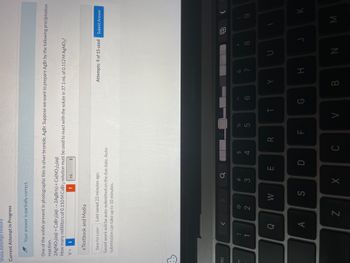
Chemistry
10th Edition
ISBN: 9781305957404
Author: Steven S. Zumdahl, Susan A. Zumdahl, Donald J. DeCoste
Publisher: Cengage Learning
expand_more
expand_more
format_list_bulleted
Concept explainers
Question

Transcribed Image Text:Show Attempt History
Current Attempt in Progress
3
esc
Your answer is partially correct.
One of the solids present in photographic film is silver bromide, AgBr. Suppose we want to prepare AgBr by the following precipitation
reaction.
2AgNO3(aq) + CaBr₂(aq) → 2AgBr(s) + Ca(NO3)2(aq)
How many milliliters of 0.110 M CaBr₂ solution must be used to react with the solute in 37.1 mL of 0.112 M AgNO3?
V = i
mL
→
eTextbook and Media
Save for Later Last saved 22 minutes ago.
Saved work will be auto-submitted on the due date. Auto-
submission can take up to 10 minutes.
!
1
Q
A
N
@
2
W
S
Q
#
3
X
E
D
$
4
C
R
F
%
5
T
V
MacBook Pro
6
Attempts: 9 of 15 used Submit Answer
G
Y
B
7
H
U
N
8
J
1+
1
9
M
K
Expert Solution
This question has been solved!
Explore an expertly crafted, step-by-step solution for a thorough understanding of key concepts.
This is a popular solution
Trending nowThis is a popular solution!
Step by stepSolved in 2 steps with 1 images

Knowledge Booster
Learn more about
Need a deep-dive on the concept behind this application? Look no further. Learn more about this topic, chemistry and related others by exploring similar questions and additional content below.Similar questions
- How many moles of precipitate will be formed when 108.5 mL of 0.200 M NaBr is reacted with excess Pb(NO₃)₂ in the following chemical reaction? 2 NaBr (aq) + Pb(NO₃)₂ (aq) → PbBr₂ (s) + 2 NaNO₃ (aq)arrow_forward30.00 mL of nitric acid (HNO3) with an unknown concentration was placed into an Erlenmeyer flask. 25.35 mL of 0.1498 M Ca(OH)2 was needed to reach the neutral point. Calculate the molarity of nitric acid. Do not type units into your answer.arrow_forwardCalculate the number of milliliters of 0.587 M KOH required to precipitate all of the Mg²+ ions in 102 mL of 0.753 M MgCl₂ solution as Mg(OH)2. The equation for the reaction is: MgCl₂ (aq) + 2KOH(aq) → Mg(OH)2 (s) + 2KCl(aq) Volume = mLarrow_forward
- How many moles of precipitate will be formed when 69.3 mL of 0.350 M AgNO₃ is reacted with excess MgI₂ in the following chemical reaction? 2 AgNO₃(aq) + MgI₂(aq) → 2 AgI(s) + Mg(NO₃)₂(aq)arrow_forwardThe molarity of an aqueous solution of hydrobromic acid, HBr , is determined by titration with a 0.113 M potassium hydroxide, KOH, solution. If 30.9 mL of potassium hydroxide are required to neutralize 15.0 mL of the acid, what is the molarity of the hydrobromic acid solution? Molarity = Marrow_forwardA chemist performs a gravimetric analysis. The chemist combines 1.00 L of 2.00 M AGNO, (ag) with 1.00 L of 4.00M NaCl (ag) in an Erlenmeyer flask. Both the AgNO3 (aq) solution and the NaCl(aq) solution are colorless. After the mixture has been stirred, a cloudy white substance is observed at the bottom of the flask. What is the expected mass of AgCl (s), in grams, assuming that the yield is 100%? In the box, enter the mass to the nearest gram.arrow_forward
- Consider the reaction: Ag⁺(aq) + Cl⁻(aq) → AgCl(s) How many grams of NaCl would be needed to precipitate the Ag⁺ ions from 2.650 × 10² mL of a 0.0115 M AgNO₃ solution? The molar mass of NaCl is 58.44 g/mol.arrow_forwardA student needs to dilute a 0.47 M Pb(NO3)2 solution to make 77.0 mL of 0.22 M Pb(NO3)2. Set up the calculation by placing the values with the correct units into the equation. Then, calculate the volume, in milliliters, of the 0.47 M Pb(NO3)2 solution that is needed.arrow_forwardConsider the reaction: Ag⁺(aq) + Cl⁻(aq) → AgCl(s) How many grams of NaCl would be needed to precipitate the Ag⁺ ions from 2.600 × 10² mL of a 0.0115 M AgNO₃ solution? The molar mass of NaCl is 58.44 g/mol.arrow_forward
- To analyze the alcohol content of a certain wine, a chemist needs 1.02 L of an aqueous 0.328 M K 2Cr 2O 7 (potassium dichromate) solution. How much solid K 2Cr 2O 7 must be weighed to make this solution?arrow_forwardHow many grams of Cu(OH)2 will precipitate when excess NaOH solution is added to 60.0 mL of 0.684 M CuBr2 solution? CuBr₂ (aq) + 2NaOH(aq) → Cu(OH)2 (s) + 2NaBr(aq) garrow_forwardPhosphoric acid, H3PO4, in a solution was neutralized by titration with a barium hydroxide, Ba(OH)2 solution. If 16.2 mL of phosphoric acid solution required 46.1 mL of 0.100 M Ba(OH)2 for neutralization, what was the molarity of the phosphoric acid in the original solution?arrow_forward
arrow_back_ios
SEE MORE QUESTIONS
arrow_forward_ios
Recommended textbooks for you
 ChemistryChemistryISBN:9781305957404Author:Steven S. Zumdahl, Susan A. Zumdahl, Donald J. DeCostePublisher:Cengage Learning
ChemistryChemistryISBN:9781305957404Author:Steven S. Zumdahl, Susan A. Zumdahl, Donald J. DeCostePublisher:Cengage Learning ChemistryChemistryISBN:9781259911156Author:Raymond Chang Dr., Jason Overby ProfessorPublisher:McGraw-Hill Education
ChemistryChemistryISBN:9781259911156Author:Raymond Chang Dr., Jason Overby ProfessorPublisher:McGraw-Hill Education Principles of Instrumental AnalysisChemistryISBN:9781305577213Author:Douglas A. Skoog, F. James Holler, Stanley R. CrouchPublisher:Cengage Learning
Principles of Instrumental AnalysisChemistryISBN:9781305577213Author:Douglas A. Skoog, F. James Holler, Stanley R. CrouchPublisher:Cengage Learning Organic ChemistryChemistryISBN:9780078021558Author:Janice Gorzynski Smith Dr.Publisher:McGraw-Hill Education
Organic ChemistryChemistryISBN:9780078021558Author:Janice Gorzynski Smith Dr.Publisher:McGraw-Hill Education Chemistry: Principles and ReactionsChemistryISBN:9781305079373Author:William L. Masterton, Cecile N. HurleyPublisher:Cengage Learning
Chemistry: Principles and ReactionsChemistryISBN:9781305079373Author:William L. Masterton, Cecile N. HurleyPublisher:Cengage Learning Elementary Principles of Chemical Processes, Bind...ChemistryISBN:9781118431221Author:Richard M. Felder, Ronald W. Rousseau, Lisa G. BullardPublisher:WILEY
Elementary Principles of Chemical Processes, Bind...ChemistryISBN:9781118431221Author:Richard M. Felder, Ronald W. Rousseau, Lisa G. BullardPublisher:WILEY

Chemistry
Chemistry
ISBN:9781305957404
Author:Steven S. Zumdahl, Susan A. Zumdahl, Donald J. DeCoste
Publisher:Cengage Learning

Chemistry
Chemistry
ISBN:9781259911156
Author:Raymond Chang Dr., Jason Overby Professor
Publisher:McGraw-Hill Education

Principles of Instrumental Analysis
Chemistry
ISBN:9781305577213
Author:Douglas A. Skoog, F. James Holler, Stanley R. Crouch
Publisher:Cengage Learning

Organic Chemistry
Chemistry
ISBN:9780078021558
Author:Janice Gorzynski Smith Dr.
Publisher:McGraw-Hill Education

Chemistry: Principles and Reactions
Chemistry
ISBN:9781305079373
Author:William L. Masterton, Cecile N. Hurley
Publisher:Cengage Learning

Elementary Principles of Chemical Processes, Bind...
Chemistry
ISBN:9781118431221
Author:Richard M. Felder, Ronald W. Rousseau, Lisa G. Bullard
Publisher:WILEY